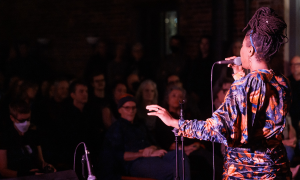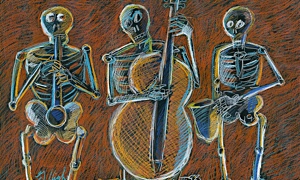Home » Jazz Articles » What is Jazz? » A Tale of Two Genres: The Surprising Similarities in the...
A Tale of Two Genres: The Surprising Similarities in the Development of Jazz and Classical Music

The two genres are, on the surface, very different from one another, and yet, the humanity and creativity that shines through across time and space speak to something else at play here...

If we consider their stylistic development from a broad, conceptual perspective, striking similarities are found. Patterns of innovation emerge in both genres that speak to some deep rooted characteristics of human creativity. Separated by time and place in such dramatic fashion, these creative minds nonetheless moved forward from era to era in spectacularly similar ways, for example:
- Textures moving from polyphony to homophony from the Baroque to Classical and from Dixieland to Swing.
- Ensembles standardized in the Classical Era (symphony orchestras and string quartets) and in the Swing Era (big band).
Figured Bass: A Short-form Notation System for the Improvising Baroque Keyboardist
Figured bass is the short-form notation system that features numbers written above bass notes. These tell the keyboardist what the notes are that should be played above the notated bass line. For example, if the bass note was a 'C' with a 3 and a 5 above it, then the keyboardist knows that the 3rd and the 5th note above 'C' are the correct notes for the intended harmony. This system does not tell the performer how or where these notes should be played—that is entirely up to the keyboardist who is therefore improvising the solution to these numerical symbols. Of course, the keyboardist was working in a stylistic framework that connected chords together using quite stringent "rules" that arose from practice. Thus, the keyboardist was improvising, but was doing so within a well-defined set of stylistic guidelines.
Johann Sebastian Bach, Cantata "Komm, süßer Tod" ("Come Sweet Death") BWV 478
Rameau's Chord Revolution
Jean-Philippe Rameau (1683-1784) was a composer and theorist who first came up with the idea of "chords" with roots. Prior to this development in the first quarter of the 18C, composers did not think of a "C chord" or a "G minor chord"—they thought in terms of the intervals above a bass note. A 'C' in the bass with an 'E' and a 'G' above was not thought of as a C chord— it was simply a 'C' in the bass with a 3rd and a 5th above it. Rameau also claimed that when another pitch from the chord was found in the bass—i.e. the C chord with an E in the bass—then it was a C chord that had been "inverted" with its 3rd in the bass and its root (C) above it. Since Rameau's conceptual breakthrough, his chord theory and its concomitant ideas on chord inversion revolutionized classical music theory, but is also the preferred method of short form notation for popular music of all kinds.Jazz Leadsheets (Figured Soprano?): A Short-form Notation System for All Improvising Jazz Musicians
If this had followed suit with other developments, we would have expected to find it being adopted in the Swing Era. It was likely being utilized in that era to some degree, but the chord notation system used in jazz really came to the fore in the 1940s.It is very much akin with the figured bass practices in the Baroque, except that the single note melody provided in the manuscript is not the bass (although the bass notes are identified in the chord symbol)—it is the melody, or the "soprano." In this chord notation, the chords are written above the melody, sometimes with quite explicit information about what notes are in the chord as in the example below), sometimes without.

Leadsheet for "Blue In Green" by Miles Davis and Bill Evans
The pianist or guitarist in a jazz setting reads these symbols and, as in the Baroque era, improvises a chordal accompaniment. This accompaniment, while improvised, must, however, still adhere to stylistic proclivities—a set of "rules" that, as with the figured bass realization in the Baroque, arose from practice.
Unlike figured bass, these symbols are also read by the all of the instrumentalists. The bassist improvises a bass line using these symbols, the horns base their improvisations on them, and the drummer, along with the entire ensemble, use them to identify the form of the piece. (With this in mind, it reminds us anew how astonishing this perfectly poised and crafted piece of music is, created from such an impossibly minimalistic sketch that was rendered, on a first take no less, into a masterwork by Miles Davis and his all-star ensemble on Kind of Blue (Columbia, 1959).)
In Closing
These are two of the most celebrated genres of "art music," for lack of a better term, but their origins could not be more disparate. The creative geniuses in each genre are separated by hundreds of years. They come from different continents, different cultures, different races, different political systems, and different folk music roots. As such, the two genres are, on the surface, very different from one another, and yet, the humanity and creativity that shines through across time and space speak to something else at play here—an unfathomably deep connection that defies the temporal, geographical, racial, cultural and the myriad other differences, revealing instead the shared human spirit that is manifested in these powerful artistic expressions.Tags
PREVIOUS / NEXT
Support All About Jazz
 All About Jazz has been a pillar of jazz since 1995, championing it as an art form and, more importantly, supporting the musicians who make it. Our enduring commitment has made "AAJ" one of the most culturally important websites of its kind, read by hundreds of thousands of fans, musicians and industry figures every month.
All About Jazz has been a pillar of jazz since 1995, championing it as an art form and, more importantly, supporting the musicians who make it. Our enduring commitment has made "AAJ" one of the most culturally important websites of its kind, read by hundreds of thousands of fans, musicians and industry figures every month.
























